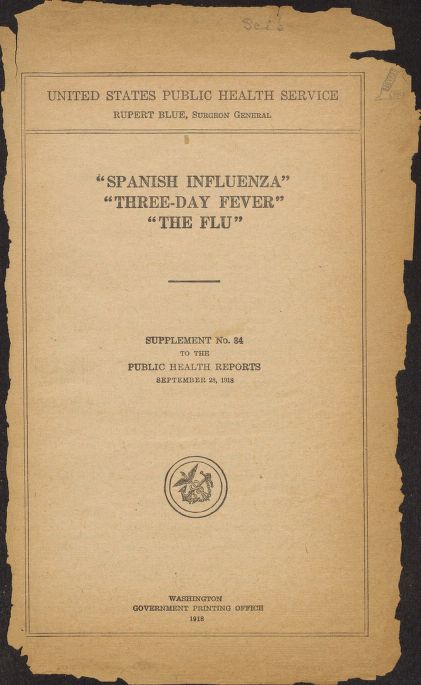Spanish Influenza in North America, 1918–1919
 Spanish Influenza in North America, 1918–1919
Spanish Influenza in North America, 1918–1919
Spanish Influenza, Three-Day Fever, The Flu. From the holdings of Harry Elkins Widener Memorial Library—Harvard College Library.
The Spanish influenza pandemic, which began in 1918, caught every nation by surprise. It infected an estimated 500 million people and killed 50 to 100 million of them in three waves. Governments around the world responded in ways that were reactive and almost ineffective before the pandemic ended in 1919 just as suddenly as it began one year earlier.
The Spanish influenza pandemic differed from previous influenza pandemics in its unprecedented virulence. Its unique characteristics included unusually high case fatality, especially among 20– to 40–year-olds.
Allies fighting in World War I designated this pandemic “Spanish” influenza because Spain’s uncensored press was the first to report freely on its widespread distribution. Elsewhere in Europe, governments feared that such newspaper reports would undermine public morale.
The First Wave of Spanish Influenza in the US
Epidemiological data indicate that pandemic began in the US in March 1918, at a crowded army camp in Fort Riley, Kansas. Subsequently, the transport of hundreds of thousands of infected troops in close physical contact between camps caused influenza to spread quickly even before troops assembled in East Coast ports en route to France. The troops brought the influenza to the trenches of the opposing armies and to other parts of Europe and beyond.
The overall response to the mild first wave of the influenza epidemic in the US was relatively subdued compared with the second and third more deadly waves.
The Second and Third Waves of Spanish Influenza in the US
The second wave struck lethally in September 1918 at a naval facility in Boston and at the Camp Devens military base in Massachusetts. At the nearby US Naval Radio School, located at Harvard University, however, few of the 5,000 trainees contracted Spanish influenza after the first cases were reported on September 6, 1918. Infected trainees were quarantined, and Harvard University took precautions to contain influenza and resume normal operations; nevertheless, six students died.
Nationwide, October 1918 was the most deadly month, when 195,000 Americans died. The supply of health care workers, morticians, and gravediggers dwindled, and mass graves were often dug to bury the dead. Among the survivors was Amelia Earhart.
The third wave of the pandemic, between late 1918 and March 1919, spread unevenly in the US and in parts of Europe, but with similar intensity as the second.
Reaction and Response
The general public grew anxious and criticized public health officials for their incompetence. Medical practitioners and researchers struggled to unravel the confusing epidemiology and pathology of this extraordinarily deadly outbreak of influenza. Major US cities banned or enforced restrictions on public gatherings, and schools, town halls, and churches served as emergency hospitals.
Legacies of Spanish Influenza
The rapid spread and unusually high case mortality of Spanish influenza called for global action against the recurrence of such a deadly influenza pandemic. To this end, international organizations such as the Centers for Disease Control and Prevention (CDC) and the World Health Organization (WHO) provide leadership in global health matters. The WHO’s preparedness plans against influenza pandemics include six levels of pandemic alert, which determine the recommended actions it should take in conjunction with the international community, governments, and industry. The CDC, together with the Ethics Subcommittee of the Advisory Committee to the Director, has provided a foundation for ethical decision-making during planning for and responding to pandemic influenza, such as Spanish influenza or epidemics of avian influenza, a contagious disease caused by viruses that infect birds but that can, on rare occasions, also infect pigs as well as people.
Selected Contagion Resources
This is a partial list of digitized materials available in Contagion: Historical Views of Diseases and Epidemics. For additional materials on the topic “Spanish Influenza in North America, 1918–1919,” click here or search the collection’s Catalog and Full Text databases.